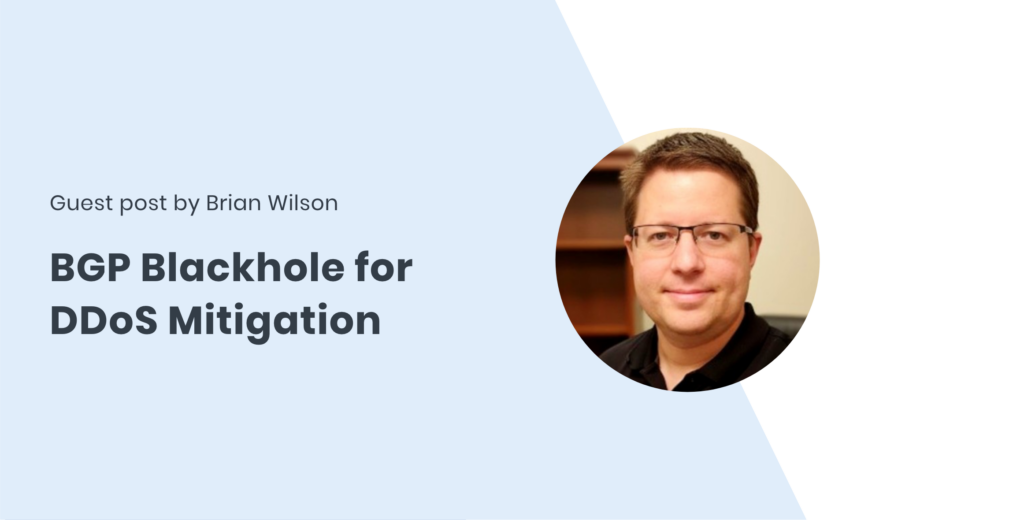We are pleased to welcome a guest contributor: BGP Brian (Brian Wilson). Brian leads the BGP Black Belt training community and the consultancy BGP Engineering and Design Group, and is an active voice on LinkedIn discussing all things BGP.
Border Gateway Protocol (BGP), as you’re probably aware, is the routing protocol of the Internet. It allows autonomous systems (i.e. large organizations like service providers or enterprises) to exchange routing information.
However, one of the more interesting uses of BGP is to serve as a control mechanism for mitigating DDoS attacks. This approach, known as BGP blackholing or Remote Triggered Black Hole (RTBH) filtering, is simple, effective, and supported by virtually all major routers.
In this post, we’ll examine how RTBH works in detail and how FastNetMon can automate its deployment for faster and more consistent DDoS response.
What is a DDoS Attack?
A DDoS (Distributed Denial of Service) attack is when a target such as an IP address, website, or network service is flooded with massive volumes of traffic from distributed sources. These attacks are often carried out using large botnets with thousands or even hundreds of thousands of compromised devices.
Because the traffic comes from so many sources, it’s nearly impossible to stop the attack by blocking a single IP or host. The result is predictable: legitimate traffic can’t get through, and the service becomes unavailable.
DDoS attacks have become one of the most common and disruptive cybersecurity threats. Every major ISP, hosting provider, and enterprise network has had to develop strategies to defend against them.
The Traditional Response: Manual Null Routing
On a single router, one of the quickest ways to drop unwanted traffic is to create a static null route. For example, to configure this on a Cisco router:
ip route [target-ip] Null0
This sends all traffic to the target IP destination to a “black hole”, i.e. simply dropping it. While this works for one router, it quickly becomes impractical for large networks with hundreds or thousands of routers.
Even worse, the attack traffic might still traverse part of your network before being dropped, consuming bandwidth and potentially affecting other services.
A more efficient way to handle DDoS attacks is to use BGP.
Using BGP for Blackholing
BGP allows you to propagate routing information across your entire network, or even to your upstream providers. By announcing a route for the attacked IP address with a special community value, you can signal to your upstream carrier to drop that traffic before it ever reaches you.
This process is called Remote Triggered Black Hole (RTBH) filtering.
For example:
- You advertise the attacked IP prefix to your upstream provider via BGP.
- You attach a special community (e.g. <ASN>:666) via a route map.
- Your upstream provider’s routers recognize the community and automatically route traffic for that IP to a null interface.
This results in the malicious traffic being stopped upstream, ideally as close to the source as possible, before it can overwhelm your network.
Blackholing Inside Your Own Network
You can also deploy internal blackholing, for example if you yourself are a service provider.
This involves creating a static route on every router in your network that drops all traffic to a fixed “dummy” ip address (say 192.0.2.1):
ip route 192.0.2.1 Null0
Then, when a specific IP is attacked, you use BGP to advertise a route for that IP with the dummy address as its next hop:
ip route [target-ip] 192.0.2.1
The advantage here is that you only have to configure this route once, and then use the network command or redistribution to inject it into BGP, which will advertise the route throughout your network. After a recursive route lookup, each router will resolve the next hop to Null0, and drop the malicious traffic.
Automating Blackhole Routing with FastNetMon
Traditionally, blackholing was a manual process. Network engineers detected attacks, logged into routers, and triggered null routes themselves. But this is a time consuming process that can leave parts of your network unavailable for long periods of time.
That’s where FastNetMon comes in.
FastNetMon continuously monitors your network using NetFlow, analyzing traffic patterns in real time. When it detects an anomaly that looks like a DDoS attack (for example, a sudden spike in packets per second to a single host) it automatically triggers a BGP announcement for the target IP with the blackhole community or a dummy next-hop.
Your routers (and optionally your upstream providers) propagate this route and start dropping traffic for that destination. Once the attack subsides, FastNetMon automatically withdraws the route, restoring normal service.
Importantly, FastNetMon doesn’t need to run on a router. It can run on a dedicated server that peers with your routers via BGP. That makes integration simple and non-intrusive.
Final Thoughts
BGP blackholing remains one of the simplest and most powerful DDoS mitigation techniques. And with automation tools like FastNetMon, it’s easier than ever to implement.
By combining real-time monitoring, instant reaction, and upstream cooperation, FastNetMon helps ensure that DDoS attacks are stopped at the edge. Or better yet, before they even reach your network.
To learn more about how FastNetMon automates RTBH and integrates with your routing infrastructure, visit: https://fastnetmon.com/bgp-blackhole-automation/
About the Author
BGP Brian (Brian Wilson) runs a BGP training community on Discord called BGP Black Belt, as well as the consulting firm BGP Engineering and Design Group. He also regularly posts about BGP topics on LinkedIn. You can find him at www.linkedin.com/in/brianwilson-bgp.
About FastNetMon
FastNetMon is a leading solution for network security, offering advanced DDoS detection and mitigation. With real-time analytics and rapid response capabilities, FastNetMon helps organisations protect their infrastructure from evolving cyber threats.
For more information, visit https://fastnetmon.com

